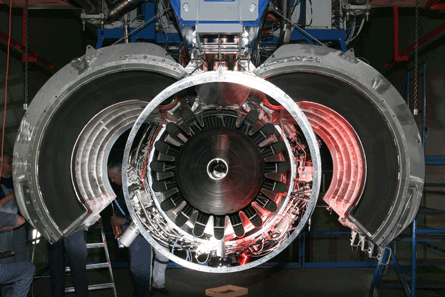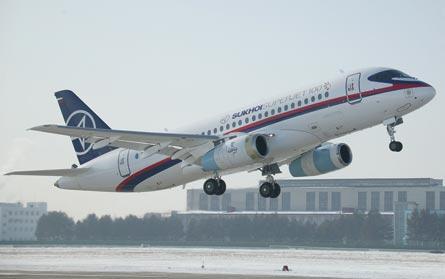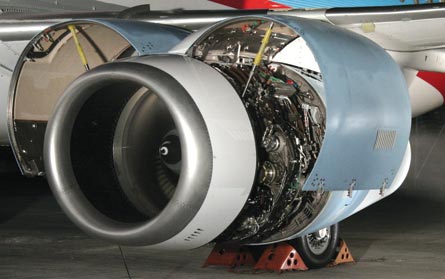Just an hour before joint venture PowerJet received formal European certification for its SaM146 engine, its Russian manufacturer NPO Saturn explained - with remarkable frankness - why the programme was running two years behind schedule.
"Because we lied to ourselves, and we lied to our French partners," admitted Saturn chief executive Ilya Fyodorov to Flight International, at European Aviation Safety Agency headquarters in Cologne in June.
PowerJet's French partner is Snecma, which builds the high-pressure sections of the SaM146, while Saturn is responsible for the low-pressure components and casing.
The two sides have co-operated on the design since 2001. Testing on the engine, designed for the Sukhoi Superjet 100, started in mid-2006 and certification had been expected in March 2008, at least according to the publicised version of the schedule.
 |
|---|
© PowerJet |
But evidence of programme creep - notably a hold-up of several months to on-wing testing with the Ilyushin Il-76 testbed, and the slippage of deliveries to customers - indicated that the situation backstage was not running as smoothly as desired.
Snecma chief executive Philippe Petitcolin diplomatically maintains that the production problems did not emerge from the French side of the SaM146 operation.
"All I can say is that the Snecma sections were on time," he says.
Saturn's Fyodorov explains that the Russian manufacturer has struggled to adapt to the Western-style processes and afford the tooling, and trained personnel, necessary to machine critical components, such as turbine blades, to the standard required.
He suggests that, earlier in the programme, there was pressure to give over-optimistic projections on the company's ability to handle the workload and development schedule, to try to secure backing.
But no more, Fyodorov insists: "We've stopped lying and become an absolutely open company."
Snecma is a "tough", "rigid" and "demanding" partner, he says, which has been "pulling Saturn with iron hands". But he adds: "We're very thankful for that - it's unpleasant but required."
To bring the SaM146 programme into line the manufacturer had to draw up a "realistic timeframe", he says: "Right now we're following that schedule. The Russian state is providing great support."
With the mainstay Tupolev Tu-154 and Tu-134 fleet fading into retirement, and the encroachment of foreign-built regional jets into Russian fleets, the Superjet 100 and SaM146 programme is viewed as the best chance for the domestic commercial aircraft industry to regain its shaky footing.
But co-operating with Snecma has required a "change of mentality", says Fyodorov, to "turn our company into a Western company". Saturn recruited consultant McKinsey to assess its production processes and advise on lean manufacturing strategies to prepare the manufacture for meeting ramp-up demands.

"As soon as Russia starts working in the Soviet way it's a disaster for the company. The Russian system was disintegrated and now we have to integrate it again," Fyodorov says.
Sukhoi conceded late last year that its chances of delivering the first Superjets to Armavia and Aeroflot by the end of 2009 were slim, as production issues had a knock-on effect on the certification flight tests.
The airframer admitted earlier this year that the bottleneck in SaM146 engine supply meant it was having to make the most of a pool of test powerplants, to the extent of removing engines from one flight-test Superjet prototype to allow another to fly. Even the first serial production aircraft, it said, would have to be fitted with pre-production engines for ground tests.
But with the successful certification by the European Aviation Safety Agency on 23 June, and Russian approval set to follow, Fyodorov is optimistic that the situation is back under control. Russian prime minister Vladimir Putin toured the Saturn facility a few days earlier, following completion of the crucial blade-out and bird-ingestion tests on the SaM146.
|
|---|
"His estimation of progress is very high," says Fyodorov. "He is very happy that we did not let him down on the certification timeframe."
Approval from the government is crucial. Saturn, which is 88%-owned by the industrial holding Oboronprom, has laid out a need for Rb8.4 billion ($270 million) in funding to support increased production.
PowerJet is intending to deliver 13 serial production SaM146s to Sukhoi this year - one of which will be a spare - but Snecma's Petitcolin says that, in 2011, the venture is aiming to manufacture 30-50. "We hope for 50," he adds.
Fyodorov says: "Next year we hope to approach that level. We need only one thing - to get the money. There's a full explanation [to the state] for why we need it. We treat state financing very seriously and account for every penny."
Saturn's financial plan requires funding of Rb3.5 billion in the first year, Rb3.9 billion in the second and Rb1.9 billion in the third, he says: "After three years we're going to be a completely new company."
The company is forecasting a production output of up to 84 engines in 2011, increasing to 120 and then 150 in the following two years.
Saturn put a new training centre into operation in March, designed to turn out skilled workers in manufacturing as well as SaM146 maintenance activity - although Fyodorov also says that the firm is overstaffed by 15-20% and wants to cut its top management and retire its older personnel. "The company has to become younger," he says. "The average age is 43, we want to make it less than 40."
He says the cuts are necessary for the company's long-term survival but admits that while, in Moscow, "you can fire people and it's no problem", heavy job losses would amount to a "very serious social explosion" in a relatively small city such as Rybinsk, where SaM146 parts are machined and the engine has undergone testing.
PowerJet chief Jean-Paul Ebanga says that, following the "long and demanding journey" to EASA approval of the SaM146, production ramp-up is one of two areas on which the venture is focusing. The other is the preparation of entry into service and the establishment of a solid support network for the aircraft and its engines.
"It's a work in progress," he says, adding that the joint activities with airlines have already been initiated. The company is also finalising a spares warehouse in the Moscow area.
Deliveries of the first production engines to Sukhoi are to take place by the end of July.
SUKHOI OPTIMISTIC OF FARNBOROUGH SALES
Two Sukhoi Superjet 100s will be delivered by the end of 2010, the engine manufacturing team has indicated, while the airframer expects to seal additional business for the type at the Farnborough air show.
Russian flag carrier Aeroflot, which has 30 on order, and Yerevan-based Armavia, with two, are set to be the first airlines to receive the aircraft.
Certification of the PowerJet SaM146 engine, and transfer of production powerplants to Sukhoi from this month, will provide a much-needed lift to the programme, which was supposed to start delivering the Superjet to Aeroflot in November 2008.
Sukhoi still wants to land a breakthrough Western deal for the twinjet, and a revelation in the airframer's annual report in late June even listed a deal with Alitalia for 20 of the type - a disclosure that was hastily withdrawn amid claims from the company that it had listed the Italian airline "by mistake".
"New orders are expected to be signed at Farnborough," says Sukhoi, while its Italian-based marketing partner Superjet International said earlier this year that it hoped to reach a pact with a Western company at the show.
Alitalia's supposedly inadvertent listing was just one curiosity contained in the annual report, which appeared to indicate that the backlog - given as 123 aircraft - has undergone several changes over the past year.
At the time of the Paris air show in June 2009 the airframer had registered 122 firm orders for the aircraft from nine customers. But two Russian carriers - AirUnion and Dalavia - have ceased operations and Sukhoi is no longer counting their combined order for 21, leaving it with 101 aircraft.
Aeroflot and Armavia have 32 Superjets on order. Armavia is scheduled to take at least one of the first two deliveries this year.
Russian lessor Avialeasing has 24 in the backlog and Sukhoi says the 10-strong order for Finance Leasing is still intact, although the annual report listed these as two firm and eight optioned aircraft. Finance Leasing signed an agreement last August to supply two Superjets to Siberian carrier Yakutia.
Sukhoi estimates demand for the aircraft in Russia and the CIS at 270 airframes over the 20 years to 2029, with another 530 aircraft bound for export.
"Superjet is a Western aircraft, and the engine is a Western engine," adds PowerJet partner NPO Saturn's chief, Ilya Fyodorov, who sees the Superjet as a strong contender to replace the Tupolev Tu-134 and Tu-154 fleet. "The Tu-154 was a major workhorse, but expensive in maintenance and support."
Sukhoi says there are three non-Russian customers for the Superjet: ItAli Airlines with an order for 10, Asset Management Advisors with five, and an undisclosed customer for 20.
But the annual report data, before it was removed, indicated a different composition. It listed ItAli's order but attributed another 15 and 20 aircraft to customers respectively identified as SOGECA and ACE, and gave a total firm order figure of 123.
ARJ21 FLIGHT-TEST PROGRAMME PASSES 500H MARK
The 20-month-long flight-test effort of the 90-seat China's ARJ21 regional jet has reached a new milestone, and engine supplier General Electric is on track to deliver the first production engine in the fourth quarter.
A senior source at Comac says the ARJ21-700 has completed around 540 flight hours as part of its flight-test programme, which began on 28 November 2008. There are four GE CF34-10A-powered ARJ21-700s in the flight-test programme.
GE general manager for the CF34 turbofan programme, Chuck Nugent, says the engine-maker has also delivered spare engines to Comac and produced three -10A engines for GE's own ground test programme that was carried out in the USA and totalled 750h of testing.
"We have validated all the changes to the -10A via ground testing and the additional testing will be done as part of the ARJ21 flight-test programme," he says.
"Engine certification is nearing completion and we expect to receive US approval in the next month or two," he says. This will be followed by Chinese CAR 25 certification, he adds.
The first production engine is due to be delivered to Comac in the fourth quarter, says Nugent. He adds that, being a variant of the proven CF34 family, the -10A engine has been performing well in the flight tests.
Nugent says the CF34-10A is "a derivative of the CF34-10E engine used on the Embraer 190/195. Essentially the turbofan engine is nearly identical, although we made some changes to support the ARJ21's fuselage-mounted application and we made some minor improvements."
The CF34-10E is installed under the E-Jet's wing, whereas the ARJ21's -10A engine is mounted on each side of the rear fuselage.
"We designed a completely new nacelle, driven by the fuselage mounted configuration, and there were some slight aerodynamic improvements achieved with the nacelle," Nugent says, adding: "We also redesigned some structural components for the fuselage mounting, so we looked to reduce weight. We've been implementing fuel reduction improvements to the -10E and -10A."
Nugent adds, that GE is in the process of introducing a new fan blade for the -10E and -10A that promises to deliver "a slight improvement" in fuel burn.
Flight tests have mostly been taking place at China's National Flight Test Centre in Xian but there have also been cold weather flight tests in China's Inner Mongolia province.
Designed for hot and high operations, Comac's ARJ21 is China's first indigenous regional jet. The programme is being bankrolled by the Chinese government, which has said that it wants the aircraft for new regional routes in remote parts of western China, an area synonymous with mountainous and hot terrain.
Comac had aimed to receive Chinese certification to allow deliveries to begin by the end of this year, but the consensus among industry sources in China is that this is likely to slip to early next year.
Source: Flight International

















